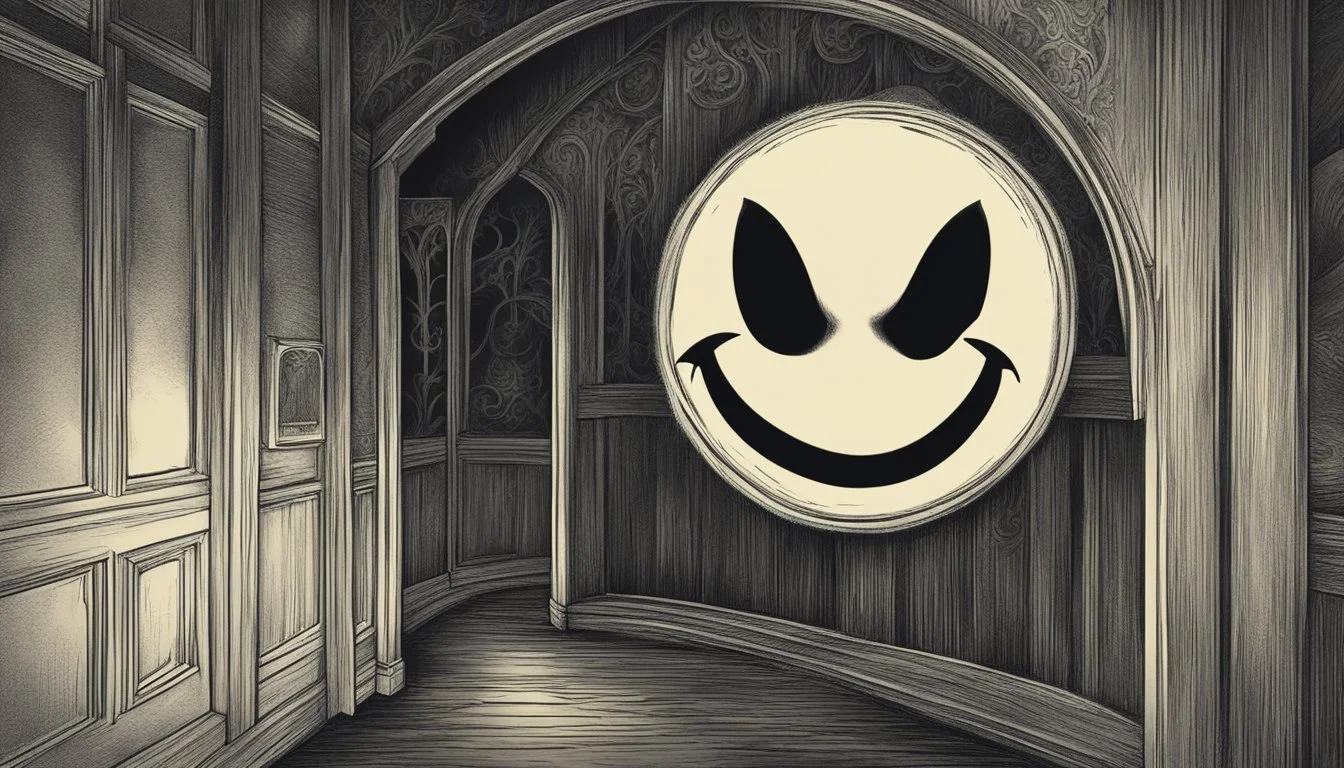Keith Hunter Jesperson: 7 Haunting Films About the Happy Face Killer
A Cinematic Look at the Notorious Serial Murderer
Keith Hunter Jesperson, known as the "Happy Face Killer," terrorized the United States in the early 1990s. His chilling crimes have since captivated the public imagination, leading to numerous film adaptations that explore his disturbing psyche and brutal actions.
These seven films offer viewers a haunting glimpse into the mind of a serial killer who taunted authorities with smiley-face-adorned letters. From made-for-TV movies to documentaries, each production takes a unique approach to portraying Jesperson's life and crimes. The films examine various aspects of his story, including his troubled childhood, his modus operandi, and the investigation that ultimately led to his capture.
1) Happy Face Killer (2014)
Happy Face Killer is a made-for-television film that premiered on Lifetime in 2014. It depicts the chilling true story of Keith Hunter Jesperson, a serial killer who terrorized the United States in the 1990s.
David Arquette stars as Jesperson, delivering a haunting portrayal of the notorious murderer. Gloria Reuben plays Melinda Gand, the lead FBI investigator tasked with tracking down the elusive killer.
The film explores Jesperson's five-year killing spree, during which he murdered at least eight women. It also delves into his disturbing habit of taunting authorities with letters and confessions signed with a smiley face, which earned him the moniker "Happy Face Killer."
Directed by Rick Bota, the movie aims to provide insight into the mind of a serial killer while showcasing the relentless efforts of law enforcement to bring him to justice.
Happy Face Killer offers viewers a glimpse into one of America's most infamous criminal cases, blending true crime elements with dramatic storytelling.
2) I Survived the Happy Face Serial Killer (2021)
This true crime documentary recounts the harrowing experiences of Daun Slagle, a survivor of Keith Hunter Jesperson's brutal attacks. Slagle shares her firsthand account of encountering the notorious Happy Face Killer in 1990.
The film explores how Slagle managed to escape Jesperson's grasp and lived to tell her story. It provides insight into the killer's methods and psychology through the perspective of someone who narrowly avoided becoming another victim.
Interviews with law enforcement officials and true crime experts supplement Slagle's narrative. The documentary examines how Jesperson's crimes went undetected for years before his eventual capture and conviction.
I Survived the Happy Face Serial Killer offers a unique survivor's perspective on one of America's most infamous serial killers. It sheds light on the lasting impact of Jesperson's actions on those who lived through his reign of terror.
https://www.imdb.com/title/tt14145436/
3) Keith Hunter Jesperson: The Happy Face Killer (2008)
This made-for-television film explores the crimes of Keith Hunter Jesperson, the infamous serial killer known as the "Happy Face Killer." The movie delves into Jesperson's murderous spree during the early 1990s.
The film depicts Jesperson's tragic past and his descent into violence. It showcases his method of targeting vulnerable women, often sex workers and transients, across multiple states.
A key focus of the movie is Jesperson's communication with the media and authorities. It portrays his habit of sending letters marked with smiley faces, which earned him his notorious moniker.
The film also touches on the investigation that ultimately led to Jesperson's capture in 1995. It highlights the role of his final victim, Julie Winningham, in bringing about his downfall.
Through dramatized events, the movie provides insight into the mind of a serial killer and the impact of his crimes on the victims' families and communities.
https://www.imdb.com/title/tt1237828/
4) Dark Minds: The Happy Face Killer (2013)
"Dark Minds: The Happy Face Killer" aired as part of the Investigation Discovery series "Dark Minds" in 2013. The episode focused on Keith Hunter Jesperson's crimes and the investigation that led to his capture.
The show featured interviews with law enforcement officials and criminal profilers who worked on the case. It provided viewers with a detailed look at Jesperson's modus operandi and the challenges faced by investigators.
The episode explored Jesperson's background and the factors that may have contributed to his violent behavior. It also examined the impact of his crimes on the victims' families and communities.
"Dark Minds" utilized reenactments to illustrate key events in the case, giving viewers a visual representation of the investigation's progression. The show's format combined these dramatizations with expert commentary to create a comprehensive narrative.
The episode highlighted Jesperson's use of the media to gain attention, including his letters to newspapers signed with a smiley face. This unique aspect of the case became a central focus of the show's exploration of the killer's psychology.
5) Happy Face Killer: The Hunt for a Serial Killer (2016)
This made-for-television film aired on Lifetime and dramatizes the investigation to capture Keith Hunter Jesperson. It stars David Arquette as Jesperson, the notorious serial killer who terrorized the United States in the early 1990s.
The movie focuses on the efforts of law enforcement to track down and apprehend Jesperson. It portrays his killing spree across multiple states and the challenges faced by investigators in connecting the crimes.
The film depicts Jesperson's signature method of taunting authorities by sending letters signed with a smiley face. This earned him the moniker "Happy Face Killer" and added a chilling element to the manhunt.
Arquette's performance brings to life Jesperson's complex personality, showcasing both his charming public persona and his dark, violent impulses. The movie provides insight into the killer's background and motivations.
While taking some dramatic liberties, the film strives to present an accurate portrayal of the real-life case. It highlights the dedication of the detectives involved and the impact of Jesperson's crimes on the victims' families.
https://www.imdb.com/title/tt5591148/
6) Born to Kill? The Happy Face Killer (2012)
Born to Kill? The Happy Face Killer is a documentary that aired as part of the Born to Kill? series on Investigation Discovery. This episode delves into the life and crimes of Keith Hunter Jesperson.
The film explores Jesperson's troubled childhood and his progression into a serial killer. It examines the psychological factors that may have contributed to his murderous behavior.
Interviews with law enforcement officials and experts provide insight into the investigation and capture of Jesperson. The documentary also discusses his notorious habit of sending letters with smiley faces to the media.
Born to Kill? The Happy Face Killer offers a comprehensive look at Jesperson's crimes and their impact on the victims' families. It presents a balanced portrayal of the killer, avoiding sensationalism while still conveying the gravity of his actions.
The documentary serves as an informative resource for those interested in true crime and the psychology of serial killers. It provides a factual account of Jesperson's case without glorifying his crimes.
https://www.imdb.com/title/tt2369335/
7) Keith Jesperson: The Killer's Own Words (2015)
This documentary provides a chilling glimpse into the mind of Keith Hunter Jesperson through his own statements. The film features recorded interviews with Jesperson, allowing viewers to hear directly from the notorious "Happy Face Killer."
Jesperson recounts details of his crimes in a matter-of-fact manner, revealing the calculated nature of his actions. His calm demeanor while discussing heinous acts is particularly unsettling.
The documentary explores Jesperson's background and potential motivations. It examines his childhood, relationships, and experiences as a long-haul truck driver that may have contributed to his criminal behavior.
Interspersed with Jesperson's words are insights from law enforcement officials and forensic psychologists. These experts offer analysis of Jesperson's statements and behavior patterns.
The film serves as a stark reminder of the complexities involved in understanding serial killers. It provides a unique perspective by allowing the perpetrator to tell his own story, while maintaining a critical lens on his accounts.
https://www.imdb.com/title/tt5563316/
Overview of Keith Hunter Jesperson
Keith Hunter Jesperson, known as the "Happy Face Killer," was a Canadian-American serial killer who murdered at least eight women in the United States during the early 1990s. His nickname stemmed from the smiley faces he drew on letters sent to the media and authorities.
Early Life and Background
Keith Hunter Jesperson was born on April 6, 1955, in British Columbia, Canada. He grew up in a turbulent household, experiencing abuse and neglect during his formative years.
As a child, Jesperson exhibited troubling behavior, including torturing animals. This early sign of antisocial tendencies foreshadowed his future crimes.
In adulthood, Jesperson worked as a long-haul truck driver. This profession allowed him to travel extensively across the United States, providing opportunities for his criminal activities.
Crimes and Modus Operandi
Between 1990 and 1995, Jesperson committed a series of brutal murders. His victims were primarily sex workers and transient women, chosen for their vulnerability and lack of connection to him.
Jesperson's modus operandi involved strangling his victims, often using items like electrical cords or his bare hands. He would then dispose of the bodies in remote locations along his trucking routes.
The killer gained notoriety for sending taunting letters to the media and law enforcement. These letters, signed with a smiley face, led to his moniker "The Happy Face Killer."
Jesperson was eventually apprehended in 1995. He confessed to eight murders, though he has claimed responsibility for more. He is currently serving multiple life sentences in prison.
Impact on Popular Culture
Keith Hunter Jesperson's crimes and persona as the "Happy Face Killer" have left an indelible mark on popular culture. His chilling story has been featured in numerous true crime documentaries, books, and films, captivating audiences and sparking discussions about criminal psychology.
Media Coverage and Public Perception
Jesperson's case garnered significant media attention due to its unusual elements. His habit of drawing smiley faces on letters to the media and authorities led to the memorable "Happy Face Killer" moniker. This distinctive signature captured public imagination and made headlines across the country.
True crime enthusiasts have shown particular interest in Jesperson's case, analyzing his motives and methods. Online forums and podcasts frequently discuss the details of his crimes and the false confession that initially complicated the investigation.
Psychological Analysis in Films
Several films and documentaries have explored Jesperson's psychology and criminal profile. These productions often feature interviews with criminal psychologists and forensic experts who provide insights into his behavior patterns and potential motivations.
Some films focus on the investigative process that led to Jesperson's capture, highlighting the challenges law enforcement faced in tracking a long-haul trucker who committed crimes across multiple states. Others delve into his troubled childhood and personal relationships, attempting to understand the factors that may have contributed to his violent tendencies.
These psychological analyses in film have contributed to broader discussions about serial killer psychology and the nature of criminal profiling in modern law enforcement.
Legacy and Controversies
Keith Hunter Jesperson's case left a lasting impact on the criminal justice system and public consciousness. His actions and subsequent legal proceedings sparked debates about serial killers and their motives.
Legal Proceedings and Sentencing
Jesperson received multiple life sentences for his crimes. He is currently incarcerated at the Oregon State Penitentiary in Salem. His case involved complex legal proceedings across several states.
DNA evidence played a crucial role in linking Jesperson to his victims. This highlighted the importance of forensic technology in solving cold cases.
Jesperson's willingness to confess and provide details about his crimes aided investigators. However, it also raised questions about the reliability of serial killer confessions.
Controversial Aspects and Debates
The "Happy Face Killer" moniker, given by an Oregon journalist, became a subject of debate. Some argued it sensationalized Jesperson's crimes and gave him undue attention.
Jesperson's letters and confessions to media outlets stirred controversy. They raised ethical concerns about how the press should handle communications from convicted killers.
The case of Taunja Bennett, Jesperson's first victim, initially led to a wrongful conviction. This highlighted flaws in the justice system and the dangers of false confessions.
Ongoing efforts to identify Jesperson's last unknown victim underscore the long-lasting impact of his crimes. It demonstrates the challenges in solving cold cases and bringing closure to victims' families.







